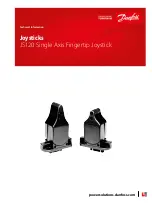
21
Instruction Book
IB019008EN October 2016 www.eaton.com
FP-25-LV-VSR
Breaker-To-Motor Starter Conversion
WARNING
FAILURE TO REMOVE ALL SHORTING WIRE FROM CURRENT
TRANSFORMERS AND SECONDARY CONNECTIONS MAY CAUSE INJURIES
AND EQUIPMENT DAMAGE.
Secondary Circuit
WARNING
BEFORE PERFORMING SECONDARY INSULATION CHECK, PLACE A JUMPER
ON THE CONTACTOR COIL ASSEMBLY POINTS (A) TO (B). FAILURE TO DO
SO MAY RESULT IN DAMAGE TO THE SOLID STATE RECTIFIER IN THE COIL
ASSEMBLY.
1. Ensure that a jumper is placed on contactor coil assembly points
(A) to (B).
2. Connect all points of the secondary disconnect pins with a
shorting wire.
3. Connect the CTs with a shorting wire and connect them to the
frame.
4. Connect the high potential lead of the test machine to the
secondary block.
5. Ground the LV-VSR frame.
6. Starting with zero, increase the voltage to 1200 Vac RMS, 60 Hz.
Maintain the voltage for one minute.
7. Successful withstand indicates satisfactory insulation strength of
the secondary control circuit.
8. Remove ALL shorting wire on the CTs and secondary block
before placing unit back into service.
9. Remove the jumper from the contactor coil assembly points (A)
to (B).
WARNING
FAILURE TO REMOVE ALL SHORTING WIRE FROM CURRENT
TRANSFORMERS AND SECONDARY CONNECTIONS MAY CAUSE INJURIES
AND EQUIPMENT DAMAGE.
6.8 Mechanism Check
Make a careful visual inspection of the mechanism for any loose
parts such as bolts, nuts, pins, rings, etc. Check for excessive wear
or damage to the LV-VSR components. Operate the LV-VSR several
times electrically to verify operation.
6.9 Lubrication
All parts that require lubrication have been lubricated during the
assembly with molybdenum disulphide grease (Eaton No.53701QB).
Over a period of time, this lubricant may be pushed out of the way
or degrade. Proper lubrication at regular intervals is essential for
maintaining the reliable performance of the mechanism. The LV-VSR
should be re-lubricated once a year. The locations shown in Figure
30 should be lubricated with a drop of non-synthetic light machine
oil. After lubrication, operate the LV-VSR several times manually and
electrically.
6.10 Primary Circuit Resistance Check
Since the main contacts are inside the vacuum chamber they remain
clean and require no maintenance at any time.
The DC resistance of the primary circuit may be calculated by
measuring the voltage drop across the circuit. To check the primary
circuit resistance, remove the LV-VSR from the switchgear, close
the LV-VSR, and pass at least 10A DC through one of the breaker’s
poles. Measure the voltage drop across the primary contacts and
calculate the resistance. Repeat for the remaining two poles.
6.11 Magnet Operating Range
If the magnet chatters, look for mechanical interference that
prevents the magnet from being aligned. The magnet gap can be
seen from the left and right sides with the help of a flashlight. A
screwdriver inserted into one of the long slots can be used as a
lever to put a corrective set into the mounting plate around the
magnet. It should not be necessary to do this unless the contactor
has been damaged and it can be seen that the armature does not fit
against the magnet. A poor magnet to armature fit usually produces
a high dropout voltage and/or chatter.
Mechanical interference can be produced by various incorrect
adjustments. Two specific points to check are:
1. Armature travel is incorrect, causing the contact springs to be
compressed into a solid, non-resilient “tube” that stops the
crossbar rigidly. Refer to Eaton’s Electrical Services and Systems
for assistance.
2. The auxiliary contact mounting brackets are mis-adjusted, so
that a contact plunger bottoms solidly before the magnet seals.
When the contactor is fully sealed closed, there should still be a
small amount of travel remaining for the plungers.
Figure 6.2. Lubrication Point




































